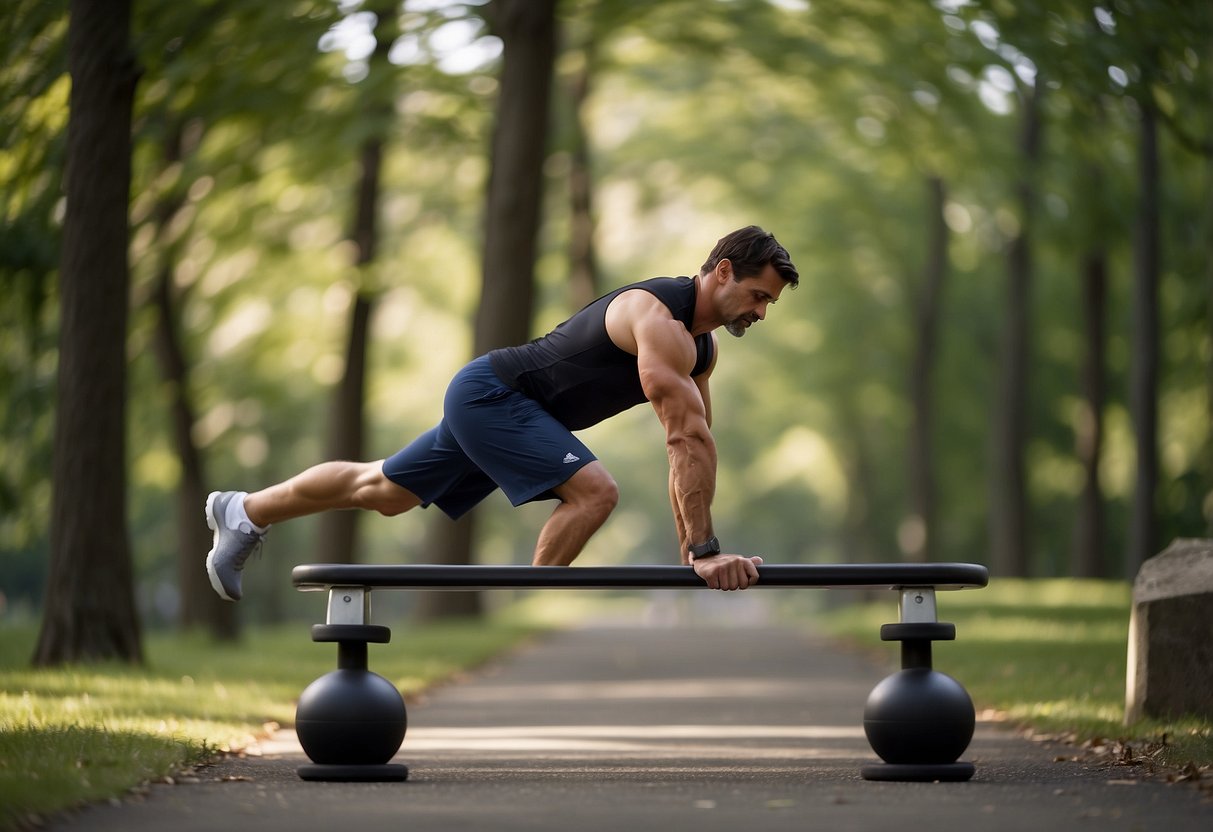Workout routine with static holds can be a game-changer for seniors, offering a safe and effective way to improve strength, balance, and overall well-being. This article delves into the benefits of incorporating static holds into your workout routine, providing guidance on creating a balanced plan that caters to the specific needs of older adults. Discover how static holds can help seniors maintain independence, reduce the risk of falls, and enhance their quality of life.
Creating a Balanced Workout Routine with Static Holds: Maximize Strength and Stability
Static holds are a powerful addition to any workout routine. These exercises involve maintaining a fixed position for a set time, challenging your muscles in unique ways. By adding static holds to your workouts, you can boost strength, build muscle, and improve endurance.

Static holds can increase muscle mass and strength by keeping your muscles under tension for longer periods. This prolonged tension breaks down muscle fibers, leading to greater growth when they repair. Static holds also help improve your mind-muscle connection, making your workouts more effective overall.
Creating a balanced routine with static holds is simple. You can mix them with your regular exercises or dedicate specific days to isometric training. Popular static holds include planks, wall sits, and chin-up holds. Remember to start slowly and gradually increase your hold times as you get stronger.

Key Takeaways
- Static holds improve strength and muscle growth by keeping muscles under tension
- Mixing static holds with dynamic exercises creates a well-rounded workout routine
- Start with short hold times and slowly increase duration as you build strength
Understanding Static Holds
Static holds are exercises where you maintain a fixed position without movement. They build strength and endurance in specific muscle groups. These holds challenge your muscles in unique ways compared to regular exercises.

Benefits of Static Holds in Training
Static holds improve muscle endurance. They teach your body to maintain tension for longer periods. This can boost your performance in other exercises and daily activities.
Static holds also build mental toughness. Holding a position for an extended time tests your willpower and focus.
These exercises are great for beginners and advanced athletes alike. They’re low-impact and can be done with minimal equipment.
Static holds can enhance your balance and stability. Exercises like planks or wall sits strengthen your core and improve posture.
Physiology Behind Muscle Endurance and Strength
During a static hold, your muscles work hard to maintain a single position. This creates constant tension, which leads to muscle fatigue.
Your body responds by building more muscle fibers. It also improves the efficiency of existing fibers. This results in increased strength and endurance over time.
Static holds boost blood flow to your muscles. This increased circulation helps deliver more nutrients and oxygen to the working tissues.
These exercises also improve your mind-muscle connection. By holding a position, you become more aware of which muscles are working and how they feel.
Fundamentals of a Balanced Workout Routine
A balanced workout routine includes different types of exercises and targets various muscle groups. It’s important to choose the right exercises and put them in the best order.
Incorporating Various Muscle Groups
When creating your workout plan, include exercises for all major muscle groups. This means working your legs, chest, back, shoulders, and arms. Don’t forget about your core muscles too.
Strength training should be a key part of your routine. It helps build muscle and boost your metabolism. Add exercises like squats for legs, push-ups for chest, and rows for back.
Cardio is also vital. It improves heart health and burns calories. You can try running, cycling, or using an elliptical machine.
Don’t skip flexibility work. Stretching helps prevent injuries and keeps you limber. Try yoga or simple stretches after your workouts.
Exercise Selection and Sequencing
Choose exercises that give you the most bang for your buck. Compound movements like deadlifts, bench presses, and pull-ups work multiple muscle groups at once. They’re great for building strength and saving time.
Start with big, complex movements when you’re fresh. Do squats or deadlifts before leg extensions. This lets you lift heavier weights and get better results.
Mix up your routine to avoid boredom and plateaus. You can change the number of sets, reps, or the exercises themselves.
Rest is crucial too. Give each muscle group at least a day to recover between workouts. This helps prevent injury and allows for muscle growth.
Designing Your Routine
Creating a balanced workout routine with static holds requires careful planning and attention to detail. You’ll need to set clear goals, manage intensity, allow for proper recovery, and apply progressive overload.

Setting Realistic Goals
Start by defining what you want to achieve with static holds. Do you aim to build strength, improve endurance, or enhance overall fitness? Be specific and measurable in your objectives. For example, you might set a goal to hold a plank for 2 minutes or maintain a wall sit for 90 seconds.
Write down your goals and give yourself a timeline. This could be 4 weeks, 8 weeks, or even 3 months. Having a clear target will help you stay motivated and track your progress.
Remember to make your goals challenging but attainable. If you’re new to static holds, start with shorter durations and gradually increase them over time.
Determining Intensity and Volume
The intensity of your static holds depends on the weight used (if any) and the duration of the hold. For bodyweight exercises like planks or wall sits, aim to hold the position for 30-60 seconds initially.
For weighted static holds, choose a weight that allows you to maintain proper form for 20-30 seconds. As you get stronger, you can increase the weight or duration.
Volume refers to the total number of sets and repetitions. Start with 2-3 sets of each exercise, with 1-2 minutes of rest between sets. Gradually increase to 3-4 sets as your endurance improves.
Include 2-3 different static hold exercises in each workout session. This provides variety and targets different muscle groups.
Rest and Recovery Periods
Proper rest is crucial for muscle recovery and growth. Allow at least 48 hours between static hold workouts for the same muscle group. This gives your muscles time to repair and adapt to the stress.
During your workouts, rest for 1-2 minutes between sets of static holds. This allows your muscles to partially recover, ensuring you can maintain good form in subsequent sets.
Incorporate static holds at the end of your regular workout routine. This way, you won’t fatigue your muscles before your main exercises.
Remember to get enough sleep and maintain a balanced diet to support your recovery process.
Progressive Overload Principle
To continue making progress, you need to gradually increase the demands on your muscles. This is known as progressive overload.
For static holds, you can apply progressive overload in several ways:
- Increase the duration of the hold
- Add weight to the exercise
- Decrease rest periods between sets
- Increase the number of sets
Start by adding 5-10 seconds to your hold time each week. Once you reach your target duration, consider adding weight or increasing sets.
Track your progress in a workout log. This helps you see improvements and decide when to increase the challenge.
Remember, progress isn’t always linear. Some weeks you might plateau or even regress slightly. This is normal and part of the process.
Essential Static Hold Exercises
Static hold exercises are key for building strength and stability. They challenge your muscles in a unique way, helping you develop endurance and power. Let’s explore some essential static holds you can add to your routine.

Planks for Core Stability
Planks are a great way to strengthen your core. Start in a push-up position with your forearms on the ground. Keep your body straight from head to heels.
Hold this position for 30 seconds to 1 minute. As you get stronger, try to increase your hold time.
Focus on keeping your abs tight and your back flat. Don’t let your hips sag or your back arch.
For an extra challenge, try side planks. These target your obliques and help improve balance.
Wall Sits for Lower Body Strength
Wall sits are excellent for building leg strength. Stand with your back against a wall. Slowly slide down until your thighs are parallel to the ground.
Hold this position for 30-60 seconds. You’ll feel the burn in your quads, hamstrings, and glutes.
Keep your back flat against the wall and your knees at a 90-degree angle. Don’t let your knees extend past your toes.
To make it harder, try holding weights or extending one leg out in front of you.
Handstands for Upper Body and Core
Handstands build upper body and core strength. Start by practicing against a wall for support.
Place your hands about 6 inches from the wall. Kick up into a handstand position. Hold for 10-30 seconds, or as long as you can maintain good form.
Keep your core tight and your body in a straight line. Point your toes and squeeze your leg muscles.
As you improve, try freestanding handstands. These require more balance and control.
Always practice handstands on a soft surface to prevent injury. Use a spotter if needed, especially when learning.
Incorporating Dynamic Movements

Dynamic movements add variety and challenge to your workout routine. They improve coordination, agility, and functional strength when combined with static holds.
Combining Static and Dynamic Exercises
Start your workout with dynamic exercises to warm up. This prepares your body for the static holds that follow. Try alternating between static and dynamic exercises in a circuit format.
For example, do a plank hold for 30 seconds, then perform 10 mountain climbers. Follow this with a wall sit for 45 seconds, then do 10 bodyweight squats.
This approach keeps your heart rate up and engages different muscle groups. It also prevents boredom and makes your workout more time-efficient.
Transition Drills
Transition drills help you move smoothly between static and dynamic exercises. They improve your body control and balance.
Start with a static hold, like a high plank. Then, transition into a dynamic movement, such as bringing your knee to your elbow. Return to the plank position and repeat on the other side.
Another example is moving from a static lunge hold into walking lunges. This builds lower body strength and stability. Practice these transitions slowly at first, focusing on proper form. As you get better, increase your speed and add more complex movements.
Safety and Injury Prevention

Static holds can be safe and effective when done correctly. Following proper techniques and taking the right precautions will help you avoid injuries and get the most out of these exercises.
Proper Form and Technique
Pay close attention to your body position during static holds. Keep your core engaged and maintain a neutral spine. Don’t lock your joints, especially knees and elbows. This can put too much stress on them.
For upper body holds like planks, keep your shoulders away from your ears. In lower body holds like wall sits, make sure your knees are in line with your toes.
Prevent injury by starting with shorter hold times and gradually increasing as you get stronger. If you feel pain, stop the exercise right away.
Use a mirror or ask a friend to check your form. Good technique ensures you target the right muscles and avoid strain.
Warm-Up and Cool-Down Strategies
Always warm up before doing static holds. This gets your muscles ready and lowers injury risk. Start with 5-10 minutes of light cardio like jogging or jumping jacks.
Next, do dynamic stretches for the muscles you’ll use. For example, arm circles before plank holds or leg swings before wall sits.
After your workout, cool down with static stretches. Hold each stretch for 15-30 seconds. This helps reduce muscle soreness and improves flexibility.
Drink water before, during, and after your workout to stay hydrated. This supports muscle function and recovery.
Monitoring Progress and Making Adjustments
![]()
Keeping track of your static hold workouts and tweaking your routine over time are key to seeing results. These practices help you stay on track and get the most out of your training.
Tracking Workouts
Use a workout log to record your static hold exercises. Write down the date, exercise name, hold time, and weight used for each set. This lets you see your progress clearly.
Take notes on how you feel during and after each workout. Pay attention to muscle soreness, energy levels, and overall performance. These details can guide your future training choices.
Consider using a fitness app to log your workouts. Many apps offer tools to track static holds and other exercises. They often provide charts and graphs to visualize your progress over time.
Adapting the Routine Over Time
Increase hold times or weights when exercises become too easy. Aim to boost your hold time by 5-10 seconds or add a small amount of weight each week.
Mix up your static hold exercises every 4-6 weeks. This prevents boredom and keeps your muscles challenged. Try new variations of holds or switch to different exercises that target the same muscle groups.
Listen to your body and adjust your routine as needed. If you feel overly tired or sore, take an extra rest day. On the flip side, if you’re not feeling challenged, bump up the intensity of your workouts.
Remember to balance static holds with other types of exercises. Include dynamic movements and cardio in your overall fitness plan for well-rounded workouts.
Nutrition and Supplementation for Recovery

Proper nutrition and targeted supplements play a key role in recovering from static hold workouts. What you eat and take can help your muscles rebuild and get stronger.
Dietary Considerations
After static hold exercises, your body needs the right fuel to recover. Protein is vital for muscle repair. Aim for 20-30 grams of protein within 30 minutes of your workout. Good sources include:
- Lean meats
- Fish
- Eggs
- Greek yogurt
- Plant-based options like tofu or legumes
Don’t forget carbs. They help replenish energy stores in your muscles. Choose whole grains, fruits, or sweet potatoes.
Stay hydrated too. Water helps flush out toxins from muscle breakdown. Drink at least 8-10 glasses daily.
Supplements to Support Muscle Recovery
While a balanced diet is key, some supplements can boost recovery. Here are a few to consider:
- Whey Protein: It’s fast-absorbing and rich in amino acids. Take 20-25 grams post-workout.
- BCAAs (Branched-Chain Amino Acids): These can reduce muscle soreness and speed up recovery. Take 5-10 grams before and after exercise.
- Creatine: It helps build muscle strength. Take 5 grams daily.
- Omega-3s: These fight inflammation. Try 1-2 grams per day from fish oil or algae-based supplements.
Always check with your doctor before starting any new supplement routine.
Case Studies and Real-world Applications

A study of college athletes showed that adding static holds to their training improved their strength and endurance. The athletes who did plank holds for 60 seconds three times a week saw a 10% increase in core strength after 8 weeks.
In a fitness class setting, instructors often use wall sits as a group challenge. Participants try to hold the position for as long as possible, creating a fun and motivating atmosphere.
Physical therapists use static holds to help patients recover from injuries. For example, shoulder blade squeezes can strengthen the upper back and improve posture for those with desk jobs.
Chin-up holds are popular among rock climbers to build grip strength. By hanging from a bar for increasing durations, climbers report better performance on challenging routes.
Yoga practitioners regularly use static holds in their practice. The warrior pose, held for 30-60 seconds, builds leg strength and improves balance.
Professional athletes incorporate static holds into their routines. Basketball players might do dumbbell side holds to enhance core stability, which is crucial for quick direction changes on the court.
These real-world examples show how static holds can benefit people of all fitness levels and goals.
Adding Variety to Prevent Plateaus
Mixing up your workout routine is key to avoiding fitness plateaus. By changing exercises and incorporating different training methods, you can keep your body challenged and continue making progress.

Periodization and Training Cycles
Periodization involves dividing your training into specific phases. This approach helps prevent training plateaus and keeps your workouts fresh.
Start with a base phase to build strength and endurance. Then move to a hypertrophy phase for muscle growth. Follow this with a strength phase to increase your max lifts.
Finally, include a power phase to improve explosive movements. Each phase should last 4-6 weeks before switching to the next.
Use different static hold exercises in each phase. For example, try plank holds in the base phase and chin-up holds in the strength phase.
Cross-Training Benefits
Cross-training involves mixing different types of exercises in your routine. This variety helps prevent boredom and targets different muscle groups.
Add cardio days between your strength training sessions. Try swimming, cycling, or running to improve your overall fitness.
Include flexibility work like yoga or Pilates. These practices can enhance your static hold performance by improving balance and core strength.
Try new static hold exercises regularly. Wall sits, glute bridges, and handstands are great options to add variety to your routine.
Remember to adjust the duration and difficulty of your static holds as you progress. This constant challenge will help you avoid plateaus and keep improving.
Mental Strategies for Motivation and Consistency
Staying motivated and consistent with your workout routine can be challenging. Here are some mental strategies to help you stick with it:
Set clear, realistic goals for yourself. Write them down and put them somewhere you’ll see daily. This keeps your objectives front of mind.
Create a schedule and treat workouts like important appointments. Block out specific times for exercise on your calendar.

Mix up your routine to avoid boredom. Try new exercises or workout locations to keep things interesting.
Track your progress. Keep a log of your workouts and celebrate small wins along the way. This builds momentum and confidence.
Use positive self-talk. Remind yourself why you started and how good you’ll feel after exercising. Replace negative thoughts with encouraging ones.
Visualize success. Picture yourself completing your workout and achieving your fitness goals. This mental rehearsal can boost motivation.
Find an accountability partner or join a fitness group. Having support makes you more likely to show up and push yourself.
Reward yourself for consistency. Plan small treats or incentives for sticking to your routine. This reinforces the habit.
Prepare in advance. Lay out your workout clothes the night before. This removes barriers and makes it easier to get started.
Remember, motivation comes and goes. Focus on building habits and discipline to carry you through when motivation is low.
Workout Routine with Static Holds: A Powerful Tool for All Ages
Throughout this article, we’ve explored the benefits of incorporating static holds into your fitness regimen. From enhancing strength and balance to reducing the risk of falls and improving overall well-being, static holds offer a versatile and effective approach to staying fit.

By following the guidelines provided, you can create a personalized workout routine that suits your individual needs and abilities. Remember to start slowly, listen to your body, and gradually increase the intensity and duration of your static hold exercises. With consistent practice and a positive mindset, you’ll be well on your way to experiencing the transformative power of static holds.
So, what are you waiting for? Start your journey towards a stronger, healthier you today by incorporating static holds into your workout routine. Your future self will thank you!
Frequently Asked Questions
Static holds are a powerful addition to any workout routine. They offer unique benefits and can be easily integrated into your existing exercises. Let’s explore some common questions about static holds.
What are the key benefits of incorporating static hold exercises into my fitness routine?
Static holds can increase muscle mass and improve strength. They subject your muscles to sustained tension, which stimulates growth and enhances endurance.
Static holds also help improve your mind-muscle connection. This increased awareness can lead to better form in other exercises.
How can static holds enhance muscle growth compared to dynamic exercises?
Static holds keep your muscles under tension longer, leading to more muscle breakdown. This breakdown is crucial for building stronger, bigger muscles.
Dynamic exercises focus on movement, while static holds emphasize constant tension. This unique stress can target muscle fibers differently, promoting growth in new ways.
What is the optimal duration for holding isometric exercises to maximize strength gains?
The ideal hold time varies based on your fitness level and goals. For beginners, start with 10-30 second holds.
As you progress, aim for 30-60 second holds. Longer holds can help build endurance, while shorter, more intense holds can boost strength.
How should static holds be integrated into a balanced workout routine to ensure all muscle groups are targeted?
Include static holds 2-3 times a week in your routine. You can add them at the end of your regular exercises for each muscle group.
For example, after chest exercises, do a plank hold. After leg day, try wall sits. This ensures all muscle groups benefit from static training.
Can static holds replace dynamic exercises, or should they be used in conjunction?
Static holds should complement dynamic exercises, not replace them. A balanced routine includes both types of training.
Use static holds to enhance your dynamic exercises. They can improve your strength in specific positions, which can carry over to your regular lifts.
What are some beginner-friendly isometric exercises to start with for building a solid foundation?
Planks are an excellent starting point for core strength. They’re simple yet effective.
Wall sits are great for leg strength. Start with short holds and gradually increase duration.
Try a doorway chest hold. Stand in a doorway with your arms pressed against the sides. This targets your chest muscles.
Explore More on Static Holds and Senior Fitness!
Learn how to incorporate static holds into your workout routine and boost your strength and balance. For more expert tips, product reviews, and to connect with a supportive community focused on elderly fitness, visit our official site and join us on Facebook!

